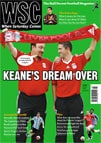 Steve Wilson recalls a time when the biggest names in football turned out for a game of six-a-side. How come it never caught on?
Steve Wilson recalls a time when the biggest names in football turned out for a game of six-a-side. How come it never caught on?
Imagine that the Masters Football tournaments that help fill the void each summer were played during the season. Now imagine that, instead of the best-supported sides being regionally invited to knock together a roster of paunchy, balding alumni, each of the 20 Premier League clubs sent along a squad padded out with first team regulars. Madness? By today’s standards, perhaps, but back in the 1980s it was a regular, and entertaining, occurrence.
In the rose-tinted days of that era any televised football beyond the one live match on a Sunday afternoon was a blessing. Consequently, the middle of December was eagerly anticipated for bringing highlights on Sportsnight of the Soccer Six tournament.
Following the standard rules of indoor football, the competition was played over a series of evenings with the winners from each night facing off in a final round robin showdown.
First contested in 1981, the winners of the first two events were Birmingham City. Arsenal, Tottenham Hotspur, Oxford United and Nottingham Forest all lifted the crown before the boom year of 1988 saw the peak of the tournament’s popularity – with all 21 First Division clubs, plus Manchester City from the Second Division, taking part. Sponsored by Guinness, that event had a total purse of £250,000 – with around £50,000 for the winners.
While the bounty on offer may not have been a major incentive, at the close of the decade there was no European football for English clubs so any extra means of income had to be taken seriously. As a result, international players such as Kevin Ratcliffe, David O’Leary, Gordon Strachan and Stuart Pearce – the like of whom wouldn’t even be troubled for a League Cup tie today – were routinely selected to captain their club’s six-a-side team.
The matches themselves – frenetic 15-minute affairs – were memorable for the unlikely heroes who emerged. Tommy Gaynor may be a footnote in the history of Nottingham Forest, but he settled the penalty shoot-out against Manchester United in the 1987 final. In 1988 David Speedie bizarrely spent the night in goal for Coventry City, while in 1989 Carl Leaburn inspired Charlton Athletic to the title. Many more stars appeared, usually wearing trainers that looked like they were regularly used to walk the dog in.
No doubt spurred by the success in the United States of the NASL’s indoor spin-off in the 1970s, the Football League were eager for a new revenue stream and Soccer Six was deemed to be an ideal complement to the outdoor game – much like cricket’s Twenty20 format. “There is a growing belief that indoor Soccer Six could well prove to be the growth sport of the 1990s,” claimed Trevor Phillips, commercial director of the Football League, at the time.
Commentator John Motson echoed the air of ambitious confidence. “It would be tempting to say that the eventual and logical extension of the tournament would be a European Cup for indoor football with the giants of the continent sending teams across to take part in Soccer Six,” exclaimed the BBC man. Both Phillips and Motson were prescient, if a little inaccurate, in their vision. Football indeed would be the growth sport of the 1990s, in its traditional form, and a new European club tournament was on the horizon.
Plans had been in place to expand the event, with several venues being used around the country while the G-Mex Centre in Manchester was to be retained as a “Wembley of indoor football” for the final showpiece. However, Luton Town won the last professional Soccer Six championship in 1990 – although the name was later revived in 1994 for an ongoing celebrity version. Despite the final event being broadcast on BSkyB, it was ultimately the arrival of satellite TV that heralded the end for top-level indoor football.
While long-standing regional events such as the Evening Standard London Fives remained until the mid-1990s, the first-team regulars of England’s top clubs would never again convene on a Perspex-enclosed patch of Astroturf. The return of English sides to Europe, combined with the profitability of the Premier League, meant that there was no need to fill out the calendar and the increased value of the top players made the concept of using them in such a tournament implausible.
The fact that no legacy emerged from the Soccer Six era is disappointing. The value given to futsal, the more skilled variation that does away with walls surrounding the pitch, in countries such as Brazil, Spain and Italy cannot be ignored given their recent international successes. Eventually in the late 1990s, Garforth Town coach Simon Clifford began promoting Futebol de Salão in the UK, with Micah Richards and John Bostock, graduates of his Brazilian Soccer Schools, emerging as living proof of the benefits.
From WSC 265 March 2009